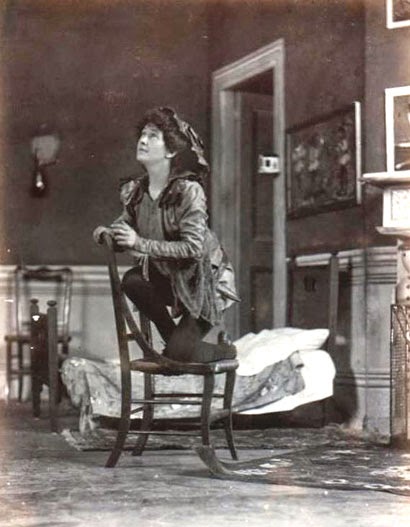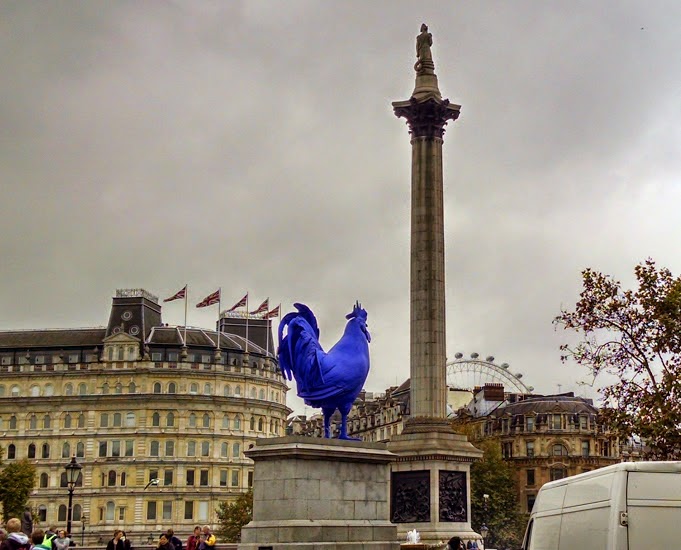Tracking the musical changes in J.M. Barrie's play is as challenging as following Peter himself through the treetops of Never Neverland. Not only did the playwright himself make changes to his work for more than twenty years, only publishing its final form in 1928, some of the songs we most associate with the play came years after that. And it seems nearly every time it's staged in the U.S. for Broadway or TV, it appears with new music.
 |
| Nina Boucicault |
Peter Pan premiered at the Duke of York's Theatre on December 27, 1904, with Nina Boucicault in the title role. Thus began the tradition of casting a woman as Peter. Barrie was never averse to the idea of a boy in the role, but child labor laws of the time prevented children from working in the theater at night, and women were considered more believable as boys than were grown men.
Producer Charles Frohman brought Peter Pan to America in 1905 with Maude Adams in the title role. Bookmice has some fun facts about the production, including the fact that Barrie was skeptical that the play would find success in the States--until it ran for ten years. Adams was a singer, and her Peter sings the bawdy "Sally in Our Alley" to the lost boys. And it was she who introduced the world to both the Peter Pan collar and Peter's feathered cap. Frohman often added music by new American songwriters to plays he brought from England, and in 1907 Jerome Kern and Paul West included a ditty called "Won't You Have a Little Feather" to a pillow dance scene with the lost boys.
 |
| Maude Adams |
The original play featured a couple of songs--"Lullaby" and "Song of the Pirates"--and a score by John Crook (composer and conductor for Duke of York's Theatre), but it wasn't until the 1950s that Peter Pan became a full musical. Leonard Bernstein wrote music for a show produced by Peter Lawrence for the 1949-1950 Broadway season, which was scaled down to "a fantasy with music," because the actress playing Peter, Jean Arthur, didn't sing. Six songs remained, three for Wendy, two for Hook (Boris Karloff) and his pirates, and one for a mermaid duo.
Barrie biographer Roger Lancelyn Green was not impressed with the changes:
By this time the craze for musicals had fallen like a blight upon the American stage, and therefore Peter Pan must be shorn of Crook's music; Leonard Bernstein must write a new score and interpolate five songs, while a ballet sequence must be devised for the Redskins, and the pirates become a chorus.
Nevertheless, Bernstein's Peter Pan was a hit with audiences and most critics--and was then overshadowed altogether by the Disney animated film in 1953. Bobby Driscoll played Peter, and an entirely new set of songs were written by Sammy Cahn and Sammy Fain. "What Makes the Red Man Red?" is one of the more awkward relics of its time, and is frequently replaced in current stagings like NBC's Peter Pan Live. "You Can Fly, You Can Fly, You Can Fly" and "Your Mother and Mine" are more fondly remembered.
 |
| Mary Martin and Cyril Ritchard |
Mary Martin became Peter in 1954 with another Broadway staging, this one with new songs yet again. Forty-five minutes of music were added, which necessitated cutting the script itself. and Jerome Robbins came on board as director, while Johnny Richards wrote music and Carolyn Leigh lyrics for "I've Gotta Crow," "I'm Flying," and "I Won't Grow Up." But the production didn't initially fall together in a way that pleased anyone, and Jule Styne, Adolph Green, and Betty Comden were brought in to add tunes, including "Never Never Land" and "Hook's Waltz" (and yes, that is the origin of this blog's name). Unfortunately, there was again a song, "Ugg-a-Wugg," which makes modern audiences cringe. New York Times critic Brooks Atkinson wrote that the score "has no audible fondness for Barrie," but this is the version of Peter Pan most often performed now in the U.S.
 |
| Danny Kaye and Mia Farrow |
And the other two NBC productions? The first was the Mary Martin staging, still beloved today, which was broadcast live on NBC on March 7, 1955 and reprised in 1956 and 1960. And in 1976, NBC produced another version of the play as a Hallmark Hall of Fame presentation, with Mia Farrow as Peter and Danny Kaye as Hook. Another new score was written, with a few strong numbers, but the overall effect was considered lackluster and the show was not broadcast again.
A Peter Pan remembered fondly by both television and theater audiences is Cathy Rigby, who took on the role from 1990 to 2013 (with more than one farewell tour, so don't count her out yet). Her performance was broadcast by A&E in 2000, and she receiving a Distinguished Lifetime Service Award from The League of American Theatres & Producers in 2004.
And the changes continue. While Peter Pan has been adapted in the 2000s in UK as panto, which doesn't stretch it too far out of its original form, new music has also been written for other UK renditions. In 2001, Peter Pan, a Musical Adventure was performed as in the UK as a concert and then made into a stage production in 2007.
I could never have followed the trail of Peter Pan stage interpretations without Bruce K. Hanson's Peter Pan on Stage and Screen 1904-2010 for much of the information in this post. Here's his blog and review of NBC's 2014 Peter Pan Live.















































